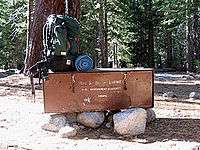Bear-resistant food storage container
Bear-resistant food storage containers, also called bear canisters or bear cans, are usually hard-sided containers used by backpackers to protect their food from theft by bears. Bear canisters are seeing increased popularity in areas where bears have become habituated to human presence, and are required[1] in some places, such as Yosemite National Park in the United States.
Construction
A bear canister[1] typically weighs between 2-4 lb (1-2 kg), and has a storage capacity of 400 - 900 in3 (6 - 15 liters). The actual capacity in number of days of hiking food stored varies with the appetite of the hiker, the selection of food, and the skill in which it is packed, but a 700 in3 canister likely holds up to a week's worth of food for the average hiker.
Hard-sided bear cans employ such materials as polycarbonate, ABS plastic, carbon fiber, and aluminum in their construction. An effective canister must resist both the tremendous strength and high intelligence of an attacking animal. Most containers are too large for a bear to simply pick up and carry away.

The lid of a canister is usually recessed in order to prevent it being pried off, and tool use, or at least an advanced degree of motor skills, is required to remove it. Some bear canisters contain gaskets that block the scent from escaping the container.
At least one model of soft-sided "bear bag" is made from Spectra (UHMWPE) fabric. While a soft-sided container may prevent a bear from eating its contents, the food inside is likely to be reduced to purée in the attempt. A newer model comes with an aluminum stiffener that protects the contents more effectively than the bag alone.
Regulations
A few national parks and national forests require backcountry visitors to carry "approved" food storage containers.[2] Backpackers who ignore this policy may face fines, property impounded, or eviction from the wilderness. Rangers may stop hikers and require them to produce their containers for inspection.
The Sierra Interagency Black Bear Group (SIBBG) and the Interagency Grizzly Bear Committee regulate the approval of food storage containers in parts of the western United States. Containers effective against the American black bears in the Sierra Nevada may not be effective against the grizzly bears found elsewhere. SIBBG conducts visual inspection and various structural tests, then containers are filled with food and left in the cages of captive black bears in a zoo in California. If the canister survives the zoo test, it is then conditionally approved. Full approval is only given after three months' successful field tests by users.

It is recommended that canisters be left on the ground, at least 100 feet /30 metres from the campsite. Suspending the canister can allow the bear to smash it to the ground or use the suspension gear to carry it away. To prevent a bear from rolling it away, a hiker can leave the container in a bush, a shallow depression, or wedged between rocks or logs. Placing the canister near water could allow the container to float away. Reflective tape and labelling the container helps in recovery.[3]
Bear bagging
An alternative is bear bagging, wherein items attractive to a bear such as food or other perishables are placed in a bag and then raised into the air with a rope — out of its reach. The rationale is that bears, being unable to reach the food, are less drawn to campsites and pose less of a threat to campers and their equipment.
Lightweight nylon stuff sacks are often used for bear bags, but they can be made simply of a large enough square or rectangular piece of cloth or tarp with the food items placed in the center of the tarp and the corners brought up and tied around with rope. The rope is then used to tie the bag in the air where it cannot be reached from the ground or from a tree by a bear. Often this is done by tying another length of rope tightly between two trees or other tall objects. In problem areas, a bear bag should be at least 12 feet (3.5 m) high and 10 feet (3 m) from any vertical support. The counterbalance method, Marrison system, and Pacific Crest Trail method are a few different techniques to use when hanging a bear bag.
In areas where trash cannot be burned (much of the United States, especially during dry seasons) and no fortified trash containers are available, trash may also be raised in a separate bear bag to keep the food smells from attracting bears.
In areas where bears pose severe problems, such as a majority of Yosemite National Park, bear bagging is ineffective and has been banned.[4]
Product failure
Yellow-Yellow, a wild 125-pound black bear in the Adirondacks near North Elba, New York, has figured out how to open several models of the BearVault, an approved container. Other bears there have reportedly also learned the skill, but those suspicions have not been confirmed.[5] For a period, the manufacturer discouraged use of the BearVault in the bears' territory.[6]
References
- REI. "Bear Canister Basics - REI Expert Advice". www.rei.com. Retrieved 2016-04-26.
- "Backcountry Camping - Grand Teton National Park (U.S. National Park Service)". www.nps.gov. Retrieved 2016-04-26.
- Bear Resistant Canisters FAQs Archived July 14, 2012, at the Wayback Machine from the New York State Department of Environmental Conservation
- Bears and Food Storage from the Yosemite National Park official website
- Foderaro, Lisa W. (July 24, 2009). "Bear-Proof Can Is Pop-Top Picnic for a Crafty Thief". The New York Times. Retrieved 2009-07-25.
- "Product Notices Archived July 30, 2009, at the Wayback Machine" BearVault.
External links
| Wikimedia Commons has media related to Bear-resistant equipment. |
- List of containers approved in the Sierras from sierrawild.gov
Appalachiantrail.org/bears